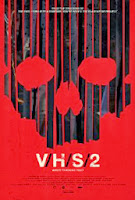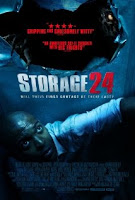Directed by: John Gulager
Writers: Patrick Melton, Marcus Dunstan
Disclaimer: If you're expecting an objective review of this movie, you came to the wrong place. Feast (the whole series) is one of my favorite things ever and I love it to death. Every single second of each of the three movies. Okay, almost every single second (we'll come to that later). I pity people who are unable to enjoy it, because in this world there's nothing like Feast, never was and probably never will be, unless by some miracle we get Feast IV, and chances for that are really slim, seeing as how Dimension screwed up the Piranha franchise. Oh, well...
Now that we got that out of the way, what's this thing about, anyway? The plot is the simplest possible - patrons in a bar in a middle of nowhere are forced to fight off the invasion of some horrifying man-eating monsters of unknown origin (which is, strangely, explained in the trailer, but not in the movie). The bastards are fast, strong, ugly, extremely hard to kill and show zero regard for human life. This last thing also goes for some of the humans.
Surely, we have seen similar stories before, but its treatment is what elevates Feast and its sequels to the level of a masterpiece of modern cinema (note that I'm not saying "in my opinion". Feast is a masterpiece, it's a fact of life and people who think otherwise are simply wrong.) Basically, it all boils down one main thing: This is a perfect combination of horror and comedy and it succeeds where its more famous predecessors like An American Werewolf in London and Shaun of the Dead failed.
Simply put, this is the way to do it. An American Werewolf in London has some masterfully directed horror scenes (the beginning in the woods, that amazing subway sequence which makes you shiver, etc.), but it also has comedy (the porno movie scene, for example) which takes a lot of the impact of the horror scenes, so we end up with a movie that's too scary to be a comedy and too funny to be a horror. Similarly, Shaun of the Dead, even though it has zombies, is essentially a drama with some elements of comedy and horror, which are again clearly separated. For me this simply doesn't work (I'm one of the minority that prefers The Howling to An American Werewolf and I've never been a big fan of Shaun). If you already have great horror scenes, why downgrade them with comedy instead of making a pure horror? I think the real horror-comedy is just like a regular comedy, except it's too gruesome for you to show it to your grandmother. It has to have the same tone from the beginning to the end, where the comedy and horror scenes are not separated, but the comedy is contained in horror. So, the goal is not to have a scary scene where a werewolf kills a guy and then a funny scene where someone is telling a joke in a bar - you're supposed to have a funny scene where a werewolf kills a guy.
And Feast is that movie! It's a pure comedy from start to finish, and quite original at that. Right at the beginning we get a supercool infodump where each of the characters is introduced by an onscreen title, stating his or her name (or, rather, nickname), some fun fact and life expectancy. The real fun begins when we meet The Hero - he's handsome (I guess), charismatic, immediately takes the leadership, organizes the defense, gives orders and his life expectancy is, quote, "pretty f***ing good". And he dies two minutes later! So we are left with a leaderless motley crew of seemingly completely incapable losers and there's more than 80 minutes of the movie left! So right from the beginning you are aware that you're watching something different.
The non-stop fun here comes mainly from the movie's unpredictability. Melton and Dunstan simply avoided all clichés in their screenplay and in some scenes they made deliberate fun of them. For example, in all movies of this type (where a group of different people are forced to unite in a fight against a stronger enemy) there has to be a scene where someone takes the spotlight and starts to talk about working together, helping each other and similar crap. Here, Henry Rollins has the honor of having the opportunity to give an emotionally charged motivational speech to the others (all while he's wearing pink underpants) and while he encourages them, one guy rolls his eyes and Balthazar Getty simply asks "Are you gay?". This is just one example and the movie's full of them. If you've seen it, you know what I'm talking about, and if not - take my word for it, because I'm not spoiling more than necessary. Anyway, the fact that you simply have no idea who's going to die next and that everyone is primarily thinking of saving his (or her) own ass is a source of almost endless fun.
In addition to having brilliant and unpredictable characters, Feast is also a truly action packed movie. I've said that the monsters are deadly, so survival is the primary (and only) goal. Finally we have a film without stupid drama and stupid romances and big speeches and similar crap that almost always pops up and ruins everything. Not here. If the characters are not dying (which is pretty often), they are arguing with each other and making plans for the action, so we don't know who lost their father in Vietnam and who was left by their boyfriend/girlfriend/husband/wife etc. - and we don't care! We only want to see another horrifying death (man or monster, it doesn't matter) and the movie flawlessly delivers. In short, watching people die has never been this fun (except in Feast 2 and 3).
Another thing where Feast is different than (most of) the other horror films is its gruesomeness. It's not just that the monsters are eating people, crushing their heads, tearing off the limbs, et cetera - there are other things that will make you think "Now did I just see THAT?". Just one example is when people in the bar decide to show one of the monsters they've killed to other monsters, to demonstrate the human superiority (another brilliant idea by Henry Rollins). So, what do the other monsters do? Naturally, they eat the body and immediately proceed to have monster sex, resulting in another small monster a few minutes later. Some of the things they do to people are even worse (for example, I could live without the head rape scene, but this "could / could not / live without this or that" discussion will be an important part of my upcoming review of Feast 2, so I won't elaborate further here).
John Gulager's direction perfectly fits Melton's and Dunstan's screenplay. The pace is extremely fast, the camera frantically flies all over, but manages to catch everything important (makers of found footage films, take note!) and it doesn't shy away from violence. If there's a scene where a head is supposed to be crushed, we see a head being crushed. When a heroine is beating a trapped monster's head, we see monster teeth flying all around. Nothing is left to our imagination and I'm grateful for that. Speaking of monsters, we get the opportunity to see them in full glory and they are really well made and horrifyingly ugly, thanks to some great make-up work by Gary J. Tunnicliffe.
Feast, while being innovative, original and unprecedentedly disgusting, still retained some conventional storytelling elements (for example, most of the characters are not completely insane), which proved to be a winning combination for most horror fans. It's rightfully considered a cult classic now. However, the sequels inexplicably managed to surpass it in insanity, so I enjoyed them even more (!). They will be reviewed here shortly and at the end of the review for Feast 3 I'll bitch a bit about the wasted potential of the Piranha series (I'm not exactly sure what does that have to do with Feast, but it crossed my mind, so...)
Just a quick note about the DVD - it contains about 40 minutes of additional material, including deleted scenes, outtakes, the making of feature and some interviews. John Gulager, Marcus Dunstan, Patrick Melton (who's very thin and looks like a total nerd, just like me, hahaha! :-) ) and some of the producers offer some interesting information about how the movie was conceived and realized, but my favorite part is the interview with Gary J. Tunnicliffe, the mastermind who designed the monsters (and even played one of them). He's a really funny English guy, totally interesting to listen to. Look for the funny story about the way he told his father that he wanted to do make-up. If you're one of the two regular visitors of this blog, you might remember him as a co-writer and co-director of the horribly bad movie called
Megalodon . Fortunately, his special effects are spot-on.
Anyway, this movie is brilliant. Get it. Seriously.



















